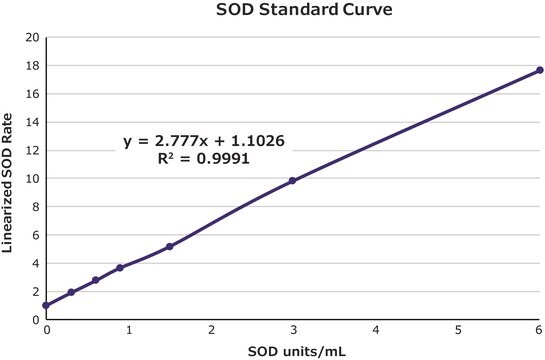MAK145
Fluorometric Intracellular Ros Kit
sufficient for 200 fluorometric tests (red)
Synonym(s):
Intracellular ROS Fluorescence Assay
Sign Into View Organizational & Contract Pricing
All Photos(2)
About This Item
UNSPSC Code:
12161503
NACRES:
NA.25
Recommended Products
usage
sufficient for 200 fluorometric tests (red)
detection method
fluorometric
relevant disease(s)
neurological disorders; cancer
storage temp.
−20°C
General description
Reactive oxygen species (ROS) are generated as a result of the reduction of oxygen during aerobic respiration and by various enzymatic systems within the cell. At physiological levels, ROS contribute to cell signaling and host defense. Increased ROS generation, above the detoxification capacity of the biological system, results in oxidative stress and cellular damage. The main damage to cells results from the ROS-induced alteration of macromolecules such as polyunsaturated fatty acids in membrane lipids, essential proteins, and DNA. ROS has been implicated in disease states, such as Alzheimer′s disease, Parkinson′s disease, cancer, and aging.
Application
Fluorometric intracellular reactive oxygen species (ROS) Kit has been used for detection of intracellular ROS in live cells.
Suitability
This kit is suitable for the detection of intracellular ROS by fluorescence microplate reader or a fluorescent microscope.
Principle
The kit provides a sensitive, one-step fluorometric assay to detect intracellular ROS (especially superoxide and hydroxyl radicals) in live cells within 1 hour incubation. ROS react with a cell-permeable sensor, resulting in a fluorometric product (λex = 520/λem = 605 nm) proportional to the amount of ROS present The assay can be performed in either a 96 or 384 multiwell plate format using a fluorescence microplate reader.
Storage Class Code
10 - Combustible liquids
WGK
WGK 3
Flash Point(F)
Not applicable
Flash Point(C)
Not applicable
Choose from one of the most recent versions:
Already Own This Product?
Find documentation for the products that you have recently purchased in the Document Library.
Customers Also Viewed
Knockdown of ferroportin accelerates erastin-induced ferroptosis in neuroblastoma cells.
Geng N, et al.
European Review for Medical and Pharmacological Sciences, 22(12), 3826-3836 (2018)
Oxidative metabolism drives inflammation-induced platinum resistance in human ovarian cancer.
Matassa D S, et al.
Cell Death and Differentiation, 23(9), 1542-1542 (2016)
Jianyong Yu et al.
Experimental and therapeutic medicine, 22(3), 946-946 (2021-07-27)
Salinomycin is a polyether antiprotozoal antibiotic that is widely used as an animal food additive. Some antifungal, antiparasitic, antiviral and anti-inflammatory activities have been reported for salinomycin. Recently, the anti-cancer effect of salinomycin has been demonstrated in breast cancer; however
Neurodegenerative diseases and oxidative stress.
Barnham K J, et al.
Nature Reviews. Drug Discovery, 3(3), 205-205 null
Yara E Elakkad et al.
Breast cancer (Dove Medical Press), 13, 675-689 (2021-12-23)
Female breast cancer is the most prevalent cancer worldwide. Emerging evidence shows that simvastatin (SIM) has promising anticancer activities. However, the underlying mechanisms are not fully elucidated. Increasing reports imply statins can modulate ferroptosis through disrupting reactive oxygen species (ROS)
Our team of scientists has experience in all areas of research including Life Science, Material Science, Chemical Synthesis, Chromatography, Analytical and many others.
Contact Technical Service


